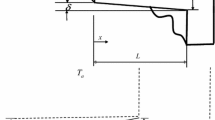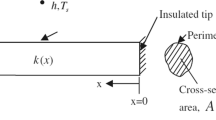Abstract
In this work, a differential evolution (DE)-based inverse analysis has been reported for maximizing the heat transfer rate from a rectangular stepped finned surface satisfying a given volume. The temperature dependency in all modes of heat transfer has been taken into the consideration, thereby making the problem highly nonlinear. In addition to conventional insulated tip assumption that signifies a linear case, nonlinear analysis with fin tip comprising simultaneous convection and radiation is also carried out. Furthermore, a numerical analysis of the transient behavior is done with the aid of the finite difference method. Due to unavailability of inverse analysis of stepped fins (literature supports this claim), for solving the problem using the DE, the concept of multiplicity of solutions satisfying a given criterion is used to search appropriate step configurations satisfying a fixed fin volume. Thereafter, step dimensions meeting the highest possible rate of heat transfer have been realized. During the DE-based optimization process, approximate analytical solutions formulated on the Adomian decomposition method (ADM) have been used for updating the pertinent fin temperature distribution. The proposed ADM-DE combination is observed to converge into a unique solution that yields the optimized design conditions under the imposed constraints.









Similar content being viewed by others
Abbreviations
- A, B, C, D, E :
-
Adomian polynomials
- A cs :
-
Cross-sectional area, m2
- Bi:
-
Biot number
- CP:
-
Probability of crossover
- F o :
-
Fourier number
- h :
-
Surface coefficient of heat transfer, W/(m2 K)
- J :
-
Objective function, m6
- k :
-
Fin material thermal conductivity, W/(m K)
- L :
-
Fin length, m
- L XX , L YY :
-
Nonlinear operators at thin and thick portions, respectively
- M :
-
Mutant in DE algorithm
- n :
-
Exponent of changeable surface coefficient of heat transfer
- np:
-
Quantity of unknown parameters
- NA, NB, NC, ND, NE:
-
Nonlinear terms
- N c :
-
Convective–conductive parameter
- N r :
-
Radiative–conductive parameter
- P :
-
Fin perimeter, m
- Q :
-
Rate of heat transfer, W
- S :
-
Scaling factor in the differential evolution algorithm
- T :
-
Temperature, K
- t s :
-
Fin semi-thickness, m
- V :
-
Fin volume, m3
- W :
-
Fin width, m
- X :
-
Non-dimensional distance along the thin section
- x :
-
Dimensional distance along the thin section, m
- Y :
-
Non-dimensional distance along the thick section
- y :
-
Dimensional distance along the thin section, m
- Z :
-
Parent vector in the differential evolution algorithm
- z :
-
Child vector in the differential evolution algorithm
- β :
-
Coefficient of changeable thermal conductivity, K−1
- δ :
-
Fin aspect ratio
- ɛ :
-
Surface emittance
- γ :
-
Coefficient of variable surface emissivity, K−1
- λ :
-
Step length ratio
- μ :
-
Thickness reduction ratio
- θ :
-
Dimensionless temperature
- ω :
-
Width to length ratio
- ζ, ψ, χ :
-
Random vectors in the DE algorithm
- a :
-
Ambient condition
- b :
-
Fin base
- FS, JS, TS:
-
Fin surface, junction surface and tip surface, respectively
- k :
-
Index for iteration in DE algorithm
- nd:
-
Dimensionless values for the coefficients of variable thermal parameters
- r :
-
Radiation sink temperature
- 1:
-
Thin section
- 2:
-
Thick section
References
Xu DH, Cheng J, Zhou X (2010) An inverse problem of thickness design for single layer textile material under low temperature. J Math Ind 2:139–146
Scott EP, Beck JV, Heldman DR (1988) Estimation of transient heat transfer coefficients in frozen foods during storage. Presented at ASME 1988 winter meet. ASME, New York, pp 55–62
Aleksashenko A (1990) Applicability of prediction formulae to inverse problems for heat and mass transfer. Theor Found Chem Eng 23:181–188
Zakharov A, Halasz S (1999) Genetic algorithms based identification method for a robot arm. In: Proceedings of IEEE international symposium on industrial electronics, ISIE’99. IEEE, pp 1014–1019
Ajith M, Das R, Uppaluri R, Mishra SC (2010) Boundary surface heat fluxes in a square enclosure with an embedded design element. J Thermophys Heat Transf 24:845–849
Singla A (2013) High-index norm approach: A redundancy resolution scheme for inverse kinematics of redundant serial manipulators. In: Proceedings of 6th robotics and mechatronics conference (RobMech). IEEE, pp 40–45
Singla RK, Singh K, Das R (2016) Tower characteristics correlation and parameter retrieval in wet-cooling tower with expanded wire mesh packing. Appl Therm Eng 96:240–249
Kabanikhin SI (2008) Definitions and examples of inverse and ill-posed problems. J Inverse Ill-Posed Probl 16:317–357
Cheng C-H, Chang M-H (2003) A simplified conjugate-gradient method for shape identification based on thermal data. Numer Heat Transf Part B Fundam 43:489–507
Das R, Ooi KT (2013) Predicting multiple combination of parameters for designing a porous fin subjected to a given temperature requirement. Energy Convers Manag 66:211–219
Gogoi TK (2016) Estimation of operating parameters of a water—LiBr vapor absorption refrigeration system through inverse analysis. J Energy Resour Technol 138:22002
Lee H-L, Wu T-S, Yang Y-C (2003) Prediction of unknown base heat flux in an annular fin by strain measurement. Int Commun Heat Mass Transf 30:115–125
Huang C-H, Yuan I-C, Ay H (2003) A three-dimensional inverse problem in imaging the local heat transfer coefficients for plate finned-tube heat exchangers. Int J Heat Mass Transf 46:3629–3638
Lee H-L, Yang Y-C (2003) Function estimation in predicting time-dependent heat flux of an annular fin. J Therm Stress 26:799–813
Huang CH, Hsiao JH (2003) An inverse design problem in determining the optimum shape of spine and longitudinal fins. Numer Heat Transf Part A Appl 43:155–177
Lee HL, Chou HM, Yang YC (2004) The function estimation in predicting heat flux of pin fins with variable heat transfer coefficients. Energy Convers Manag 45:1749–1758
Marin L, Wen X, Elliott L et al (2006) Parameter identification in two-dimensional fins using the boundary element method. Numer Heat Transf Part A Appl 50:315–344
Chen WL, Yang YC, Lee HL (2007) Inverse problem in determining convection heat transfer coefficient of an annular fin. Energy Convers Manag 48:1081–1088
Dul’kin IN, Garas’ko GI (2008) Analysis of the 1-D heat conduction problem for a single fin with temperature dependent heat transfer coefficient: part I—extended inverse and direct solutions. Int J Heat Mass Transf 51:3309–3324
Huang C-H, Chung Y-L (2010) A nonlinear fin design problem in estimating the optimal shapes of longitudinal and spine fully wet fins. Numer Heat Transf Part A Appl 57:749–776
Wang CC, Yang CY (2010) Inverse method in simultaneously estimate internal heat generation and root temperature of the T-shaped fin. Int Commun Heat Mass Transf 37:1312–1320
Gnanasekaran N, Balaji C (2011) A Bayesian approach for the simultaneous estimation of surface heat transfer coefficient and thermal conductivity from steady state experiments on fins. Int J Heat Mass Transf 54:3060–3068
Lee HL, Chang WJ, Chen WL, Yang YC (2012) Inverse heat transfer analysis of a functionally graded fin to estimate time-dependent base heat flux and temperature distributions. Energy Convers Manag 57:1–7
Azimi A, Bamdad K, Ahmadikia H (2012) Inverse hyperbolic heat conduction in fins with arbitrary profiles. Numer Heat Transf Part A Appl 61:220–240
Das R, Mallick A, Ooi KT (2013) A fin design employing an inverse approach using simplex search method. Heat Mass Transf 49:1029–1038
Das R (2014) Forward and inverse solutions of a conductive, convective and radiative cylindrical porous fin. Energy Convers Manag 87:96–106
SAS (2013) SAS/OR(R) 13.1 User’s guide: mathematical programming. 420. Accessed 24 July 2016
Salomon R (1998) Evolutionary algorithms and gradient search: similarities and differences. IEEE Trans Evol Comput 2:45–55
Luo J-C (1993) An incomplete inverse as a preconditioner for the conjugate gradient method. Comput Math Appl 25:73–79
Moles CG, Mendes P, Banga JR (2003) Parameter estimation in biochemical pathways: a comparison of global optimization methods. Genome Res 13:2467–2474
Das R, Prasad DK (2015) Prediction of porosity and thermal diffusivity in a porous fin using differential evolution algorithm. Swarm Evolut Comput 23:27–39
Das R (2015) Estimation of parameters in a fin with temperature-dependent thermal conductivity and radiation. Proc Inst Mech Eng Part E J Process Mech Eng. doi:10.1177/0954408915575386
Singla RK, Das R (2015) Adomian decomposition method for a stepped fin with all temperature-dependent modes of heat transfer. Int J Heat Mass Transf 82:447–459
Singh K, Das R, Singla RK (2016) Closed-form solution for a rectangular stepped fin involving all variable thermal parameters and nonlinear boundary conditions. Proc Inst Mech Eng Part E J Process Mech Eng. doi:10.1177/0954408916652438
Torabi M, Yaghoobi H, Kiani MR (2013) Thermal analysis of the convective-radiative fin with a step change in thickness and temperature dependent thermal conductivity. J Theor Appl Mech 51:593–602
Thermal conductivity of some common materials and gases. http://www.engineeringtoolbox.com/thermal-conductivity-d_429.html. Accessed 24 July 2016
Mikron Table of emissivity of various surfaces. http://www-eng.lbl.gov/~dw/projects/DW4229_LHC_detector_analysis/calculations/emissivity2.pdf. Accessed 24 July 2016
Storn R, Price K (1997) Differential evolution-a simple and efficient heuristic for global optimization over continuous spaces. J Glob Optim 11:341–359
Karaboga D, Ökdem S (2004) A simple and global optimization algorithm for engineering problems: differential evolution algorithm. Turk J Electr Eng Comput Sci 12:53–60
Strens MJA, Moore AW (2003) Policy search using paired comparisons. J Mach Learn Res 3:921–950
Bhowmik A, Singla RK, Roy PK et al (2013) Predicting geometry of rectangular and hyperbolic fin profiles with temperature-dependent thermal properties using decomposition and evolutionary methods. Energy Convers Manag 74:535–547
Author information
Authors and Affiliations
Corresponding author
Ethics declarations
Conflict of interest
The authors declare that they have no conflict of interest.
Rights and permissions
About this article
Cite this article
Singla, R.K., Das, R. A differential evolution algorithm for maximizing heat dissipation in stepped fins. Neural Comput & Applic 30, 3081–3093 (2018). https://doi.org/10.1007/s00521-017-2908-9
Received:
Accepted:
Published:
Issue Date:
DOI: https://doi.org/10.1007/s00521-017-2908-9




